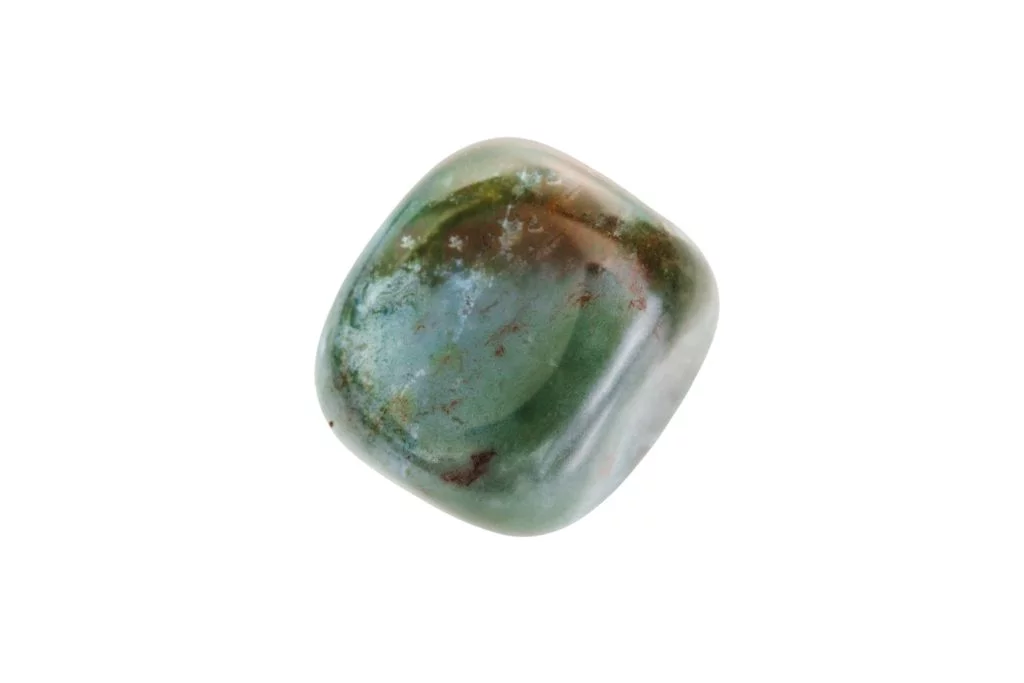Physical Appearance of Blood Jasper
Blood Jasper, also known as Bloodstone, is a striking and distinctive crystal that captivates with its unique appearance. This opaque chalcedony variety typically features a deep, dark green base color that serves as a canvas for its most notable characteristic: vibrant red or reddish-brown spots and splashes. These red inclusions, which give the stone its evocative name, are caused by iron oxide impurities and can range from small flecks to larger, more prominent splotches.
Color Variations
While the classic combination of dark green and red is most common, Blood Jasper can also occur in other color variations. Some specimens may have a lighter green or even bluish-green background, while others might display yellow or orange inclusions alongside the signature red markings. This diversity in coloration adds to the allure of Blood Jasper, making each piece unique and visually interesting.
Structure and Texture
Blood Jasper typically has a smooth, waxy luster when polished, enhancing its visual appeal. The stone’s structure is microcrystalline, meaning it’s composed of tiny, interlocking quartz crystals that are not visible to the naked eye. This fine-grained structure contributes to the stone’s durability and makes it ideal for various lapidary applications, including cabochons, beads, and decorative objects.
Unique Features
What sets Blood Jasper apart from other crystals is its distinctive patterning. The interplay between the dark background and the bright red inclusions creates a striking contrast that resembles drops of blood on a green surface. This unusual appearance has led to various metaphysical associations and historical significance, particularly in ancient cultures where it was often linked to strength, courage, and vitality. The random distribution of the red markings ensures that no two pieces of Blood Jasper are exactly alike, making each specimen a one-of-a-kind natural artwork.
Historical and Cultural Significance of Blood Jasper
Blood Jasper, also known as Bloodstone or Heliotrope, has been revered for centuries across various cultures. Ancient Egyptians believed it had magical powers to stop bleeding, while in medieval times, it was associated with the crucifixion of Christ due to its red spots resembling blood droplets. The stone was often carved into religious symbols and used in Christian art.
Metaphysical Associations
In metaphysical circles, Blood Jasper is considered a powerful healing stone. It is believed to purify the blood, boost the immune system, and enhance overall physical strength. Many practitioners associate it with the root chakra, claiming it can ground energy and increase courage. The stone is also thought to stimulate intuition and creativity, making it popular among artists and writers.
Common Uses and Benefits
Blood Jasper is widely used in jewelry and decorative objects. As a healing crystal, it is often carried as a pocket stone or worn as a pendant. Some people place it under their pillow to ward off nightmares and promote restful sleep. In alternative medicine, it is used to treat blood disorders and detoxify the body. Many believe it can help with decision-making, boost self-confidence, and provide protection against negative energies.
Modern Applications
Today, Blood Jasper continues to be popular in crystal healing practices and New Age spirituality. It is often incorporated into meditation routines and energy healing sessions. Some modern practitioners use it in feng shui to promote vitality and balance in living spaces. Its striking appearance also makes it a favorite among rock collectors and lapidary enthusiasts who appreciate its unique patterns and rich history.

